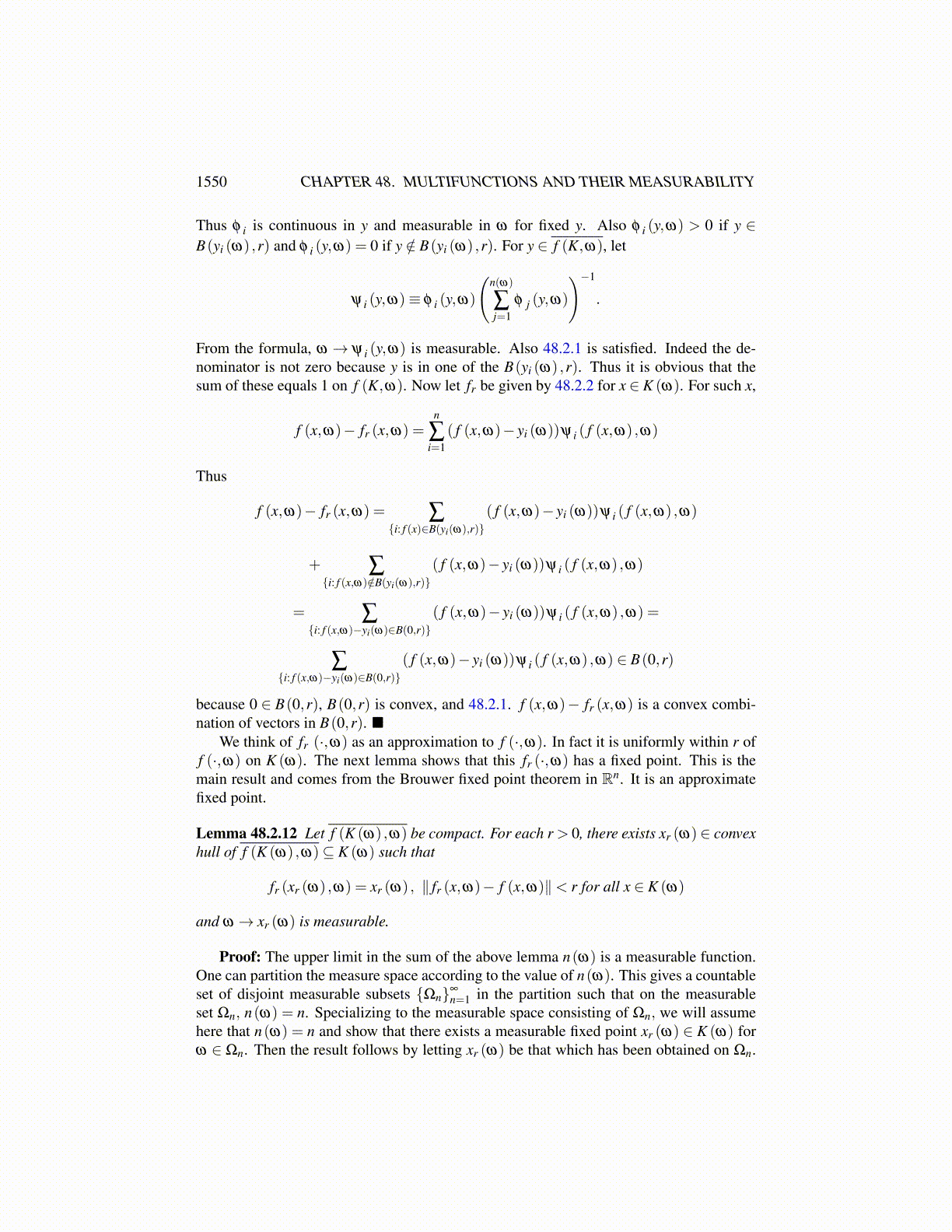
1550 CHAPTER 48. MULTIFUNCTIONS AND THEIR MEASURABILITY
ω→ψ (x(ω) ,ω) is measurable if x(ω) is. Indeed, x(ω) is the limit of a sequence {xn (ω)}such that xn has finitely many values on measurable sets, Theorem 11.3.10. Hence, by con-tinuity, ψ (x(ω) ,ω) = limn→∞ ψ (xn (ω) ,ω) and since ω → ψ (xn (ω) ,ω) is measurable,so is ψ (x(ω) ,ω).
Now with the marvelous Kuratowski theorem, one gets the following interesting resulton measurability of Brouwer fixed points.
Theorem 48.2.8 Let K be a closed convex bounded subset of Rn. Let f(·,ω) : K→ K becontinuous for each ω and ω → f(x,ω) is measurable, meaning inverse images of setsopen in K are in F where (Ω,F ) is a measurable space. Then there exists x(ω) ∈ K suchthat ω → x(ω) is measurable and f(x(ω) ,ω) = x(ω).
Proof: Simply consider E = K and ψ (x,ω)≡−|x− f(x,ω)| . It has a maximum x(ω)for each ω thanks to continuity of f(·,ω). Thanks to the Brouwer fixed point theorem,this x(ω) must be a fixed point. By the above Kuratowski theorem, one of these x(ω) ismeasurable. Obviously, by continuity of f(·,ω), ω → f(x(ω) ,ω) is measurable.
You can also let K be replaced with K (ω) where ω → K (ω) is measurable and eachK (ω) is closed, bounded, and convex.
Corollary 48.2.9 Let K (ω) be a closed convex bounded subset of Rn and let ω → K (ω)be a measurable multifunction for ω ∈ Ω with (Ω,F ) a measurable space. Let fω (·,ω) :K (ω)→ K (ω) be continuous, ω → fω (x(ω) ,ω) is measurable whenever ω → x(ω) ismeasurable and x(ω) ∈ K (ω). Then there exists a measurable fixed point
x(ω) , fω (x(ω) ,ω) = x(ω) .
Proof: Consider ψω (x,ω)≡−|fω (x(ω) ,ω)−x(ω)| . By the Brower fixed point the-orem, the maximum for fixed ω is 0. Therefore, there exists such a measurable ω→ x(ω) ,a fixed point, from Theorem 48.2.7.
You can show that for K (ω) a closed convex bounded subset of Rn which is also ameasurable multifunction, then the projection map ω→ P(ω)x is measurable. Suppose f :Rn×Ω→Rn and you know that x→ f(x,ω) is continuous. Consider f(P(ω)x,ω) . SinceP(ω) is a continuous map on Rn,x→ f(P(ω)x,ω) is continuous. If x(ω) is measurablewith values in K (ω) so it is a pointwise limit of xn (ω) having finitely many values onmeasurable sets, then one can assume all these values of xn (ω) are in K (ω) since youcould consider P(ω)xn (ω)→ P(ω)x(ω) = x(ω) and the measurability of ω → P(ω)ximplies ω → P(ω)xn (ω) is measurable. Thus
f(x(ω) ,ω) = limn→∞
f(xn (ω) ,ω)
and by assumption this last is measurable because it is a measurable function on each ofseveral measurable sets. Thus from Corollary 48.2.9, there is a measurable fixed pointx(ω) ∈ K (ω) for f so
f(P(ω)x(ω) ,ω) = f(x(ω) ,ω) = x(ω) .
This shows the following corollary.